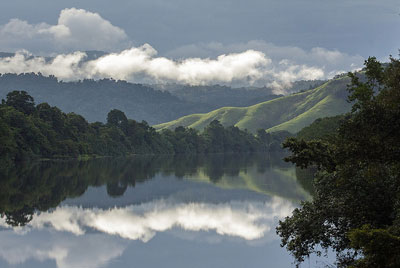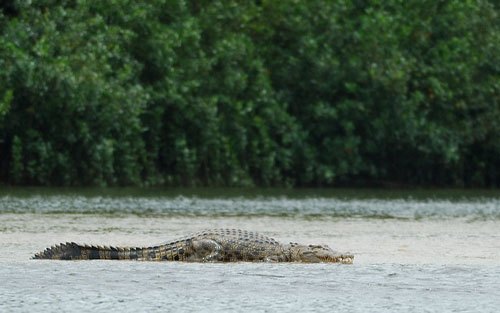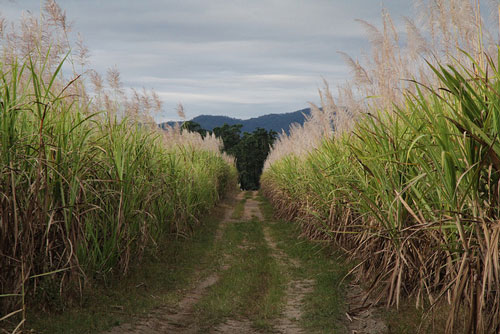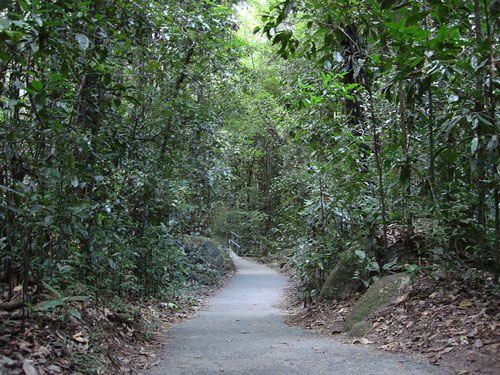Daintree Rainforest
It has always been a dream of mine to go to Australia, and after doing some research about the Daintree Rainforest it is a must for one of my destinations. There are so many interesting species of plants and animals and also a rich history! Did you know that some of plant species date back to before the dinosaur?

The Daintree Rainforest is located in the northeast corner of Australia along the coast of Queensland. The Daintree Rainforest is split into two sections divided by an agricultural piece of land. Together, the two sections cover around 1200 square kilometers of the tropical wilderness. Parts of the rainforest are protected by the Daintree National Park, which became a World Heritage Site in 1988. Some of the remaining sections of the rainforest are owned privately while other areas are State Forest.

The Daintree Rainforest is special for several reasons. It is the largest rainforest on the continent of Australia. Stretching all the way to the coast and up to the edge of the Coral Sea, the Daintree Rainforest is often referred to as where the ‘reef meets the rainforest’. Finally, it is very very old—dating back over one hundred and thirty-five million years! Since the Daintree Rainforest is one of the oldest continuous rainforests in the world, it excellently displays the major stages in the Earth’s evolutionary history.
Landscape:
There are a wide variety of landforms and diverse landscapes across the Daintree Rainforest. Among the incredible scenery are beaches, gorges, rivers, waterfalls, and mountains.
Beaches:
There are several oasis–like beaches that line the edge of the Daintree Rainforest as the region stretches right up towards the coast. The trees of the rainforest stretch right up to the edge of the sandy beaches. The beaches can be dangerous for different reasons, mainly the influence of dangerous animals such as crocodiles and jellyfish. Interestingly, part of the Great Barrier Reef—famous for its large scale and diverse species—lies on the coast of the Daintree Rainforest.
Emmagen Beach is incredible quiet with very few visitors. Donovans Beach also tends to be very quiet because crocodiles are often sighted on the beach. The large reef off the shore of Coconut Beach is a large attraction for fishing because the water's depth increases drastically at the reef. Cape Tribulation Beach is very calm and clear which is why it is a popular beach along with Noah’s Beach. The beaches of the Daintree region extend for miles with fine sand, brilliant blue water, and very little human presence.
Gorges:
Rivers:
Waterfalls:
Mountains:
The Great Dividing Range, which is Australia’s largest mountain range, stretches far along the continent. It even extends into Queensland and the Daintree region. The mountains of the region are lined with the same plants and vegetation that cover the rest of the region. Some of the highest peaks in the Daintree Rainforest are Thornton Peak (1374 meters), Mount Hemmant (1040 meters), and Mount Sorrow (743 meters).
Climate:
The Daintree Rainforest has a tropical climate all year round with variations in temperature and precipitation between the summer and winter seasons. In the winter months the average maximum temperature falls around 26°C and during the night the temperatures drop significantly. The coldest month is usually July. In summer the average maximum temperature rises to about 32°C with the hottest month usually falling on January or February.
The fall of precipitation in the Daintree Rainforest lines up with the temperature change. The winter months tend to be drier and in the summer months the rainfall is much heavier and is used to replenish the species of the rainforest that rely on the tropical climate to thrive. During some summer months like February and March there can be up to an inch of rainfall each day. It is also noteworthy that the summer months are much more humid than the winter months.
Plants:
There are around 3000 species of plants in the Daintree Rainforest—from trees to ferns to flowers and more. Over 210 families of plant species are found within the reigon and 12 of the flowering plant families that can be found in this region are primitive and date back to the dinosaur ages and before.
The Idiot Fruit is among the most noteworthy plants of the daintree rainforest and is also known as Ribbonwood or the Green Dinosaur. This particulsr flowering plant is approximately 130 million years old. The discovery of the idiot fruit occured when the poisonous seeds of the fruit killed several cows in a farmer’s field. The discovery of the idiot fruit helped scientists learn how old the daintree rainforest really is.
Many of the other plants are poisonous like the idiot fruit, such as some types of wild ginger and the seeds of the Burrawang Palm. Trees like Blue Quandongs have fruit that are safe to eat and the leaves are essential to the canopy of the rainforest. The rainforest canopy is a thick layer of jungle forest that blocks the hot sun from the forest floor. Many plants in the forest can be dangerous for explorers. At a glance the stinging tree doesn’t look dangerous but it has tiny barbs that prick the skin and cause severe itching. The wait–a–while vine uses its tiny spikes to grab at skin and rip at clothing.
Animals:
The Saltwater Crocodiles that inhabit many of the streams and rivers of the Daintree Rainforest are large and primitive in their appearance. They are also very dangerous and among the top predators of the Daintree region. Another interesting predator found in the Daintree Rainforest is the Spotted–Tailed Quoll, which is a very good hunter. It can hunt during the day as well as the night—giving it a strong advantage over its prey.
There are many brilliant bird species in the Daintree Rainforest, which is why it is a prime birdwatching area in Australia. The Southern Cassowary is a very large bird with brightly coloured neck and head feathers. The chicks of Cassowaries are much duller and only develop into the exoctic adult birds as they grow. Many birds travel away from the Rainforest during the winter season but there are still many colourful birds to spot throughout the years. More than half of the bird species on the entire Australian continent can be found in the Daintree Rainforest.
Human Presence:
Due to the human presence in the Daintree Rainforest there are several implications on the plants and animals of the area. So many of the species are endangered and since humans began to affect the area there are over 120 threatened species.
Resting along the edges of the protected areas of the Daintree Rainforest are several farmlands. Most notably are the lands that farm sugar cane near the small town of Mossman. The Daintree River also runs along the farmlands of the Daintree region. Farming is one of the main industries of the Daintree Region, which can be a problem for the rainforest as the farmers burn down trees and clear the precious species to make room for more crops. Using the land for crops can damage the land making it difficult for trees and natural vegetation to grow back.Logging and mining poses a similar threat to farming; in order to gain the resources from these industries much of the rainforest is cut down and destroyed. Since parts of the Daintree Rainforest are protected and the Daintree National Park is even a World Heritage Site, there are limitations to the impact that certain industries can have on the region.
The Rainforest is popular among tourists because of its addition to the world heritage site. The tropical wilderness that makes up the region is a big drawing point for adventurous people. Although, the dangerous plants and animals that inhabit the region and humid climate may scare some people away.Throughout the Daintree Rainforest there are so many incredible landforms and natural features that have provided cultural significance throughout the years. There a total of 18 indigenous tribes that have made the Daintree Rainforest their home over the years. They found ways to survive in the harsh environment and managed to thrive, especially in the coastal lowlands. Aboriginal groups like the Kuku Yalanji track the weather cycles of the area in order to hunt the right animals and pick the right vegetation. Interestingly, many of the intertwining trails walked by these indigenous peoples are now used by tourism groups to guide people to places of spiritual importance.
Worksheets and Other Activities:
- Rainforest Animal Crafts and Activities (from dltk-kids.com)
- Daintree Rainforest Coloring Pages (from coloring.ws)
- Crocodile On-Line Jigsaw Puzzle
- "What I've learned about the Daintree Rainforest" Coloring Worksheet
- Help the crocodile travel the river through the Daintree River Maze
- How many words can you make from DAINTREE RAINFOREST
Word Worksheet














